Marble’s popularity began in ancient Rome and Greece, where white and off-white marble were used to construct a variety of structures, from hand-held sculptures to massive pillars and buildings.
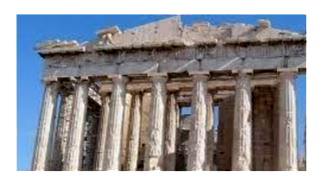
Gas A, obtained above is a reactant for a very important biochemical process which occurs in the presence of sunlight. Identify the name of the process
Respiration
Photosynthesis
Transpiration
Photolysis
The correct Answer is:B
Step by step video, text & image solution for Marble’s popularity began in ancient Rome and Greece, where white and off-white marble were used to construct a variety of structures, from hand-held sculptures to massive pillars and buildings. Gas A, obtained above is a reactant for a very important biochemical process which occurs in the presence of sunlight. Identify the name of the process by Chemistry experts to help you in doubts & scoring excellent marks in Class 10 exams.
Topper's Solved these Questions
- BOOK - OSWAL PUBLICATIONCHAPTER - NEW CHAPTERS AND QUESTIONS BASED ON LATEST TYPOLOGIES INTRODUCED BY CBSE FOR 2021-22 EXAMINATION EXERCISE - CHEMICAL REACTIONS(VISUAL CASE - BASED QUESTIONS )11videos
NEW CHAPTERS AND QUESTIONS BASED ON LATEST TYPOLOGIES INTRODUCED BY CBSE FOR 2021-22 EXAMINATION
- BOOK - OSWAL PUBLICATIONCHAPTER - NEW CHAPTERS AND QUESTIONS BASED ON LATEST TYPOLOGIES INTRODUCED BY CBSE FOR 2021-22 EXAMINATION EXERCISE - ACIDS , BASES AND SALTS (VISUAL CASE - BASED QUESTIONS )25videos
NEW CHAPTERS AND QUESTIONS BASED ON LATEST TYPOLOGIES INTRODUCED BY CBSE FOR 2021-22 EXAMINATION
- BOOK - OSWAL PUBLICATIONCHAPTER - METALS AND NON-METALSEXERCISE - Board corner(Long answer type questions)20videos
METALS AND NON-METALS
- BOOK - OSWAL PUBLICATIONCHAPTER - NTSE 2019 - 20 EXERCISE - (CHEMISTRY) ATOMS AND MOLECULES (STAGE - 2)1videos
NTSE 2019 - 20
Similar Questions
Marble’s popularity began in ancient Rome and Greece, where white and off-white marble were used to construct a variety of structures, from hand-held sculptures to massive pillars and buildings.
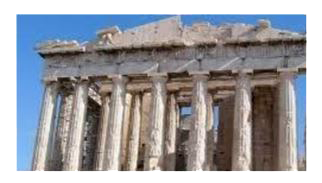
The substance not likely to contain CaCO3 isView SolutionMarble’s popularity began in ancient Rome and Greece, where white and off-white marble were used to construct a variety of structures, from hand-held sculptures to massive pillars and buildings.
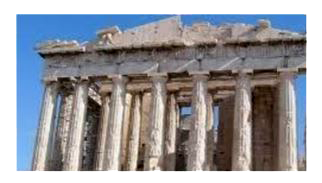
Marble statues are corroded or stained rain water. Identify the main reason
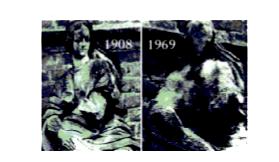 View Solution
View Solution
Knowledge Check
- Question 1 - Select One
Read the following passages and answer the questions given after them.
PASSAGE - II
The Roman Empire covered a vast stretch of territory that included most of Europe as we know it today and a large part of the Fertile Crescent and North Africa.
The Roman Empire embraced a wealth of local cultures and languages, that women had a stronger legal position then than they do in many countries today, but also that much of the economy was run on slave labour, denying freedom to substantial numbers of persons! From the fifth century onwards, the empire fell apart in the west but remained intact and exceptionally prosperous in its eastern half.
Roman historians have a rich collection of sources to go on, which we can broadly divide into three groups: (a) texts, (b) documents and (c) material remains. Textual sources include letters, speeches, sermons, laws, and histories of the period written by contemporaries. These were usually called .Annals. because the narrative was constructed on a year-by-year basis. Documentary sources include mainly inscriptions and papyri. Inscriptions were usually cut on stone, so a large number survive, in both Greek and Latin. The .papyrus. was a reedlike plant that grew along the banks of the Nile in Egypt and was processed to produce sheets of writing material that was very widely used in everyday life. Thousands of contracts, accounts, letters and official documents survive .on papyrus. and have been published by scholars who are called .papyrologists.. Material remains include a very wide assortment of items that mainly archaeologists discover (for example, through excavation and field survey), for example, buildings, monuments and other kinds of structures, pottery, coins, mosaics, even entire landscapes. Each of these sources can only tell us just so much about the past, and combining them can be a fruitful exercise, but how well this is done depends on the historian.s skill!
Who were papyrologists?APeople who processed papyrus into sheetsBScholars who published documentsCFarmers who cultivated papyrusDPeople who surveyed the reed like plants along the Nile - Question 2 - Select One
Read the following passages and answer the questions given after them.
PASSAGE - II
The Roman Empire covered a vast stretch of territory that included most of Europe as we know it today and a large part of the Fertile Crescent and North Africa.
The Roman Empire embraced a wealth of local cultures and languages, that women had a stronger legal position then than they do in many countries today, but also that much of the economy was run on slave labour, denying freedom to substantial numbers of persons! From the fifth century onwards, the empire fell apart in the west but remained intact and exceptionally prosperous in its eastern half.
Roman historians have a rich collection of sources to go on, which we can broadly divide into three groups: (a) texts, (b) documents and (c) material remains. Textual sources include letters, speeches, sermons, laws, and histories of the period written by contemporaries. These were usually called .Annals. because the narrative was constructed on a year-by-year basis. Documentary sources include mainly inscriptions and papyri. Inscriptions were usually cut on stone, so a large number survive, in both Greek and Latin. The .papyrus. was a reedlike plant that grew along the banks of the Nile in Egypt and was processed to produce sheets of writing material that was very widely used in everyday life. Thousands of contracts, accounts, letters and official documents survive .on papyrus. and have been published by scholars who are called .papyrologists.. Material remains include a very wide assortment of items that mainly archaeologists discover (for example, through excavation and field survey), for example, buildings, monuments and other kinds of structures, pottery, coins, mosaics, even entire landscapes. Each of these sources can only tell us just so much about the past, and combining them can be a fruitful exercise, but how well this is done depends on the historian.s skill!
Which of these are NOT material remains?AMosaicsBCoinsCMonumentsDAnnals - Question 3 - Select One
Read the following passages and answer the questions given after them.
PASSAGE - II
The Roman Empire covered a vast stretch of territory that included most of Europe as we know it today and a large part of the Fertile Crescent and North Africa.
The Roman Empire embraced a wealth of local cultures and languages, that women had a stronger legal position then than they do in many countries today, but also that much of the economy was run on slave labour, denying freedom to substantial numbers of persons! From the fifth century onwards, the empire fell apart in the west but remained intact and exceptionally prosperous in its eastern half.
Roman historians have a rich collection of sources to go on, which we can broadly divide into three groups: (a) texts, (b) documents and (c) material remains. Textual sources include letters, speeches, sermons, laws, and histories of the period written by contemporaries. These were usually called .Annals. because the narrative was constructed on a year-by-year basis. Documentary sources include mainly inscriptions and papyri. Inscriptions were usually cut on stone, so a large number survive, in both Greek and Latin. The .papyrus. was a reedlike plant that grew along the banks of the Nile in Egypt and was processed to produce sheets of writing material that was very widely used in everyday life. Thousands of contracts, accounts, letters and official documents survive .on papyrus. and have been published by scholars who are called .papyrologists.. Material remains include a very wide assortment of items that mainly archaeologists discover (for example, through excavation and field survey), for example, buildings, monuments and other kinds of structures, pottery, coins, mosaics, even entire landscapes. Each of these sources can only tell us just so much about the past, and combining them can be a fruitful exercise, but how well this is done depends on the historian.s skill!
Which of these statements is NOT true?ATexts, documents and material remains were the main sources for the historians.BInscriptions were carved in Greek and Latin.CArchaeologists make discoveries through excavations.DThe Roman Empire flourished longer in the west.
Marble’s popularity began in ancient Rome and Greece, where white and off-white marble were used to construct a variety of structures, from hand-held sculptures to massive pillars and buildings.
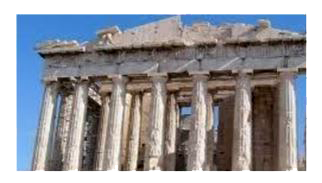
Calcium oxide can be reduced to calcium, by heating with sodium metal. Which compound would act as an oxidizing agent in the above processView SolutionMarble’s popularity began in ancient Rome and Greece, where white and off-white marble were used to construct a variety of structures, from hand-held sculptures to massive pillars and buildings.
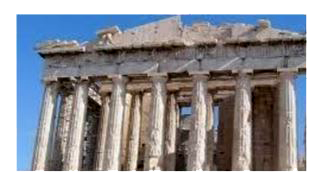
A student added 10g of calcium carbonate in a rigid container, secured it tightly and started to heat it. After some time, an increase in pressure was observed, the pressure reading was then noted at intervals of 5 mins and plotted against time, in a graph as shown below. During which time interval did maximum decomposition took place?
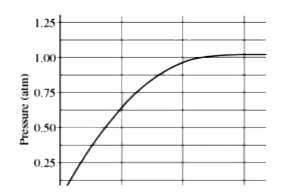 View Solution
View SolutionRead the following passages and answer the questions given after them.
PASSAGE - II
The Roman Empire covered a vast stretch of territory that included most of Europe as we know it today and a large part of the Fertile Crescent and North Africa.
The Roman Empire embraced a wealth of local cultures and languages, that women had a stronger legal position then than they do in many countries today, but also that much of the economy was run on slave labour, denying freedom to substantial numbers of persons! From the fifth century onwards, the empire fell apart in the west but remained intact and exceptionally prosperous in its eastern half.
Roman historians have a rich collection of sources to go on, which we can broadly divide into three groups: (a) texts, (b) documents and (c) material remains. Textual sources include letters, speeches, sermons, laws, and histories of the period written by contemporaries. These were usually called .Annals. because the narrative was constructed on a year-by-year basis. Documentary sources include mainly inscriptions and papyri. Inscriptions were usually cut on stone, so a large number survive, in both Greek and Latin. The .papyrus. was a reedlike plant that grew along the banks of the Nile in Egypt and was processed to produce sheets of writing material that was very widely used in everyday life. Thousands of contracts, accounts, letters and official documents survive .on papyrus. and have been published by scholars who are called .papyrologists.. Material remains include a very wide assortment of items that mainly archaeologists discover (for example, through excavation and field survey), for example, buildings, monuments and other kinds of structures, pottery, coins, mosaics, even entire landscapes. Each of these sources can only tell us just so much about the past, and combining them can be a fruitful exercise, but how well this is done depends on the historian.s skill!
Documentary sources of the history of Roman Empire includeView SolutionRead the following passages and answer the questions given after them.
PASSAGE - II
The Roman Empire covered a vast stretch of territory that included most of Europe as we know it today and a large part of the Fertile Crescent and North Africa.
The Roman Empire embraced a wealth of local cultures and languages, that women had a stronger legal position then than they do in many countries today, but also that much of the economy was run on slave labour, denying freedom to substantial numbers of persons! From the fifth century onwards, the empire fell apart in the west but remained intact and exceptionally prosperous in its eastern half.
Roman historians have a rich collection of sources to go on, which we can broadly divide into three groups: (a) texts, (b) documents and (c) material remains. Textual sources include letters, speeches, sermons, laws, and histories of the period written by contemporaries. These were usually called .Annals. because the narrative was constructed on a year-by-year basis. Documentary sources include mainly inscriptions and papyri. Inscriptions were usually cut on stone, so a large number survive, in both Greek and Latin. The .papyrus. was a reedlike plant that grew along the banks of the Nile in Egypt and was processed to produce sheets of writing material that was very widely used in everyday life. Thousands of contracts, accounts, letters and official documents survive .on papyrus. and have been published by scholars who are called .papyrologists.. Material remains include a very wide assortment of items that mainly archaeologists discover (for example, through excavation and field survey), for example, buildings, monuments and other kinds of structures, pottery, coins, mosaics, even entire landscapes. Each of these sources can only tell us just so much about the past, and combining them can be a fruitful exercise, but how well this is done depends on the historian.s skill!
Much of the economy in the Roman Empire was run onView SolutionComprehension:
Read the passage and answer the questions that follow.
The methods of embalming, or treating the dead body, that the ancient Egyptians used is called 'mummification'. Using special processes, the Egyptians removed all moisture from the body, leaving only a dried form that would not easily decay. It was important in their religion to preserve the dead body in as life like a manner as possible. The mummification process took seventy days. Special priests worked as embalmers, treating and wrapping the body. Beyond knowing the correct rituals and prayers to be performed at various stages, the priests also needed a detailed knowledge of human anatomy. The first step in the process was the removal of all internal parts that might decay rapidly. The brain was removed by carefully inserting special hooked instruments up through the nostrils in order to pull out bits of brain tissue. The embalmers then removed the organs of the abdomen and chest through a cut usually made on the left side of the abdomen. They left only the heart in place, believing it to be the center of a person's being and intelligence. The other organs were preserved separately, with the stomach, liver, lungs and intestines placed in special boxes or jars, today called 'canopic jars'. These were buried with the mummy. The embalmers next removed all moisture from the body. This they did by covering the body with 'natron', a type of salt which has great drying properties, and by placing additional natron packets inside the body. When the body had dried out completely, embalmers removed the internal packets and lightly washed the natron off the body. The result was a very dried-out but recognizable human form. To make the mummy seem even more life like, sunken areas of the body were filled out with linen and other materials and false eyes were added. Next the wrapping began. Each mummy needed hundreds of yards of linen. The priests carefully wound the long strips of linen around the body, sometimes even wrapping each finger and toe separately before wrapping the entire hand or foot. In order to protect the dead from mishapin after life, amulets were placed among the wrappings and prayers and magical words written on some of the linen strips. Often the priests placed a mask of the person's face between the layers of head bandages. At last the priests wrapped the final cloth or shroud in place and secured it with linen strips. The mummy was complete. It was then placed in the tomb along with food, furniture, vessels, perfumes, jewels and other things required in the afterlife.
SubQuestion No : 32
What was the initial step in the process of mummification?View Solution
